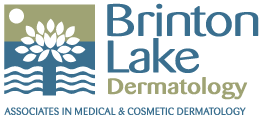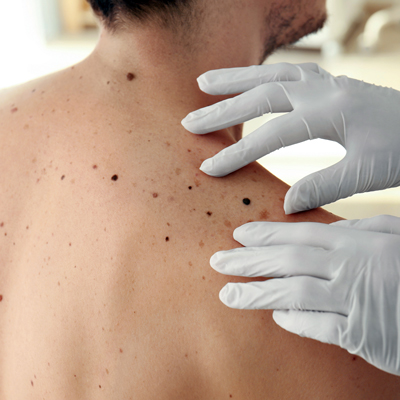Melanoma and Skin Cancer
The Facts
Screening our patients for skin cancer is an extremely important part of Brinton Lake Dermatology’s practice. Non-melanoma skin cancers are the most common cancers in men and women in the United States. It is predicted that approximately 1,000,000 new cases of basal and squamous cell carcinoma will be diagnosed each year. While these types of cancers are rarely fatal, they must be removed from the skin because they will continue to grow. Diagnosing these cancers at their earliest stages, preferably in a pre-cancerous state if possible, is important because removal of the cells can be performed as a simple, in-office procedure. In more advanced stages, basal or squamous cell cancers may need to be removed surgically at our Mohs Surgery Center.
Although less common, cutaneous malignant melanoma is the most lethal form of skin cancer. Every year, more than 96,000 people in the United States discover that they have melanoma. What is particularly troubling is that the annual number of new cases has doubled in the past 30 years, and the average age of the cancer victim has been steadily decreasing. In addition, the incidence of melanoma in young women, ages 15 to 29, has been steadily on the rise, most likely due to tanning bed usage. If detected in its early stage, melanoma can usually be treated successfully. But left undetected, melanoma can spread to internal organs and result in death. Each year, there are close to 9,000 deaths from malignant melanoma.
Who Gets Skin Cancer?
People of all colors and races get skin cancer. Those with light skin who sunburn easily have a higher risk. Risk factors include: sunburns, family history of skin cancer, exposure to x-rays, weakened immune system, use of indoor tanning beds, scarring caused by a disease or burn, and exposure to cancer-causing compounds, such as arsenic.
Visit the Skin Cancer Foundation website to learn more about skin cancer and treatment options.
Who’s at Risk?
Several risk factors increase a person’s likelihood of getting melanoma.
- Sun exposure.
- Light skin. However, melanoma can appear on dark skin tones, usually appearing on the palms, soles, under the nails, in the mouth or on the genitals.
- One or more first-degree relatives (parent, sibling or child) with melanoma.
- Lots of Moles (50-100 or more).
- Atypical moles. These may not be cancerous, but should be monitored closely for changes.
- Past history of melanoma.
What Does Skin Cancer Look Like?
There are different types of skin cancer, and each tends to look a bit different. The most commonly diagnosed pre-cancers or skin cancers are discussed here.
Actinic Keratoses (AK)
These dry, scaly patches or spots are considered the earliest stage in the development of skin cancer. In rare cases, an AK can progress to a type of skin cancer called squamous cell carcinoma (SCC). People who commonly get AKs have fair skin.. Most people see their first AKs after age 40 because AKs tend to develop after years of sun exposure. But even teenagers can have AKs if they live in sunny areas or use indoor tanning. AKs form on skin that gets lots of sun exposure, such as the head, neck, hands, and forearms. Because AKs increase the risk of getting SCC, AKs are usually treated.
Squamous Cell Carcinoma (SCC)
SCC is the second most common type of skin cancer. This skin cancer often looks like a firm bump, scaly patch, or an ulcer that heals and then re-opens. SCC is usually reddish in color. It tends to form on skin that gets frequent sun exposure, such as the rim of the ear, face, neck, arms and trunk. People who have light skin are most likely to develop SCC, but it can also develop in dark-skinned people, especially those who have scarring. Because SCC can grow deep, it can cause damage and disfigurement. Early treatment can prevent this and stop SCC from spreading.
Basal Cell Carcinoma (BCC)
This is the most common type of skin cancer. It frequently looks like a flesh-colored, pearl-like bump. It can also appear as a pinkish patch of skin. Like AKs, BCC develops on skin that gets frequent sun exposure, such as the head, neck and arms. Many BCCs also form on the trunk and lower limbs. While BCC frequently develops in people who have fair skin, it can occur in people with dark skin. BCC usually does not grow quickly, and it rarely spreads to other parts of the body. But it should be treated promptly. This cancer can invade the surrounding tissue and grow into the nerves and bones, causing damage and disfigurement.
Melanoma
This skin cancer frequently develops in a mole or appears suddenly as a new dark spot on the skin. Either way, melanoma can be deadly. Every year, more than 8,500 Americans (nearly one person per hour) die from melanoma, making melanoma the deadliest form of skin cancer.
It is estimated that more than 96,000 Americans will develop melanoma this year. A change is often the first sign of melanoma; therefore, it is important to know where moles appear and what they look like. When detected and properly treated before it spreads, melanoma has a high cure rate. The ABCDE warning signs of melanoma can help people detect change.
A B C D E Exam
Examine your skin on a regular basis and look for these telltale characteristics of melanoma.
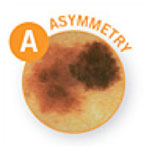
Asymmetry: One half unlike the other half.
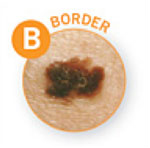
Border: Irregular, scalloped or poorly defined border.
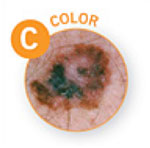
Color: Color variation — tan, brown, black, red, white or blue.
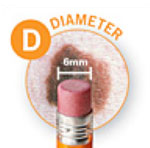
Diameter: Size greater than 6mm (the size of a pencil eraser), however, they can be smaller.

Evolving: A spot that looks different from the rest or is changing in size, shape or color.
Prevention
Sun exposure is the most preventable risk factor for all skin cancers, including melanoma. You can have fun in the sun and decrease your risk of skin cancer by following some basic guidelines:
- Generously apply a broad-spectrum, water-resistant sunscreen with an SPF of 30 or more to all exposed skin. Broad-spectrum provides protection from both ultraviolet A (UVA) and ultraviolet B (UVB) rays. Re-apply approximately every two hours, even on cloudy days, and after swimming or sweating.
- Wear protective clothing, such as a long-sleeved shirt, pants, a wide-brimmed hat and sunglasses, where possible.
- Seek shade when appropriate, remembering that the sun’s rays are strongest between 10 a.m. and 4 p.m. If your shadow is shorter than you are, seek shade.
- Protect children from sun exposure by making sure they are playing in the shade and wearing protective clothing, and by applying sunscreen.
- Use extra caution near water, snow and sand, as they reflect the damaging rays of the sun, which can increase your chance of sunburn.
- Get Vitamin D safely through a healthy diet that may include vitamin supplements.
- Avoid tanning beds. Ultraviolet light from the sun and tanning beds can cause skin cancer and wrinkling. If you want to look like you’ve been in the sun, consider using a sunless self-tanning product, but continue to use sunscreen with it.
Are Skin Exams Important?
With early detection and proper treatment, the cure rate for BCC and SCC is about 95%. When melanoma is detected before it spreads, it also has a high cure rate.
Everyone should perform regular skin exams – both self-exams and screenings by a professional. Skin cancer screening in our office involves a five to ten minute visual inspection of the patient’s entire body including the scalp, hands and feet. We will also ask you questions about any personal or family history of skin cancer, the amount of time you are typically in the sun each day and your sun protection routine. All of this information will help determine how often you should be screened for skin cancer. That frequency could range anywhere from three-month intervals to an annual screening.
